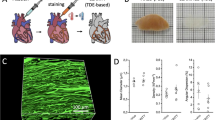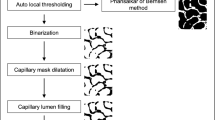Summary
In order to investigate the consequences of different types of cardiac hypertrophy on myocardial capillary and fibrosis density in rats we describe here, in the same hearts, the pattern of capillary bed density visualized by fluoresceine isothiocyanate dextran (FITC-dextran) and the pattern of fibrosis density as determined by automated image analysis. Pressure overload was induced by clipping one renal artery in rats (one-clip, two-kidney Goldblatt hypertension, RHV). Volume overload was induced by creation of an arteriovenous shunt between the abdominal aorta and the vena cava (aorto-caval fistula model ACF). Animals were sacrified at 1, 3 and 6 months following surgical procedure. Immediately prior to sacrifice, FITC-dextran (MW 150,000) was injected with the animal under ether anesthesia. Five minutes later, cardiac diastolic arrest was induced by the i.v. injection of potassium chloride. The heart was rapidly excised and placed in a formaldehyde solution. The degree of cardiac hypertrophy was calculated after measurement of cardiac weight. Left ventricular wall thickness and cavity area were measured by microscopic methods.
Capillary density and geometry were determined by morphometric methods, under ultraviolet light microscopy, using a graphic tablet connected to a microcomputer. The degree of myocardial fibrosis, visualized with Sirius Red, was estimated by the use of automated image analysis using light microscopy.
In renovascular hypertension, cardiac hypertrophy was maximum at one month (36%) and persisted through the six months of the study. This increase in cardiac mass was concentric, due to a significant increase in ventricular wall thickness and was associated with a marked increase in fibrosis and a significant decrease in subendocardial capillary density. These effects existed already one month and did not change with time.
In the aorto-caval fistula model, cardiac hypertrophy was also maximum at one month (+56%), but this eccentric increase in cardiac mass was associated with no significant change in left ventricular wall thickness, but rather with a significant increase in the surface area of the left ventricular cavity. This volume overload hypertrophy was associated with a decrease in subendocardial capillary density which was negatively correlated with time. In contrast to concentric hypertrophy there was no increase in the fibrosis density compared to the sham-operated groups.
Despite the identical degrees of hypertrophy, pressure and volume cardiac overload differed in a significant manner in both left ventricular wall thickness and cavity surface area. The observed changes in capillary bed and fibrosis density seem to be influenced predominantly by this change in geometry of the left ventricle.
Similar content being viewed by others
References
Mandache E, Gunnar U, Ljungquist A (1972) Myocardial blood capillary reaction in various forms of cardiac hypertrophy. Virchows Arch Abt Bzellpath 11:97–110
Thiedemann KU, Holubarsch CH, Medugorac I, Jacob R (1983) Connective tissue content and myocardial stiffness in pressure overload hypertrophy; a combined study of morphologic, morphometric, biochemical, and mechanical parameters. Basic Res Cardiol 78:140–155
Swinghedauw B, Piguet V, Presteseille M (1972) Adenosine triphosphatase, adenylate kinase, and collagen content of heart myofibrils in experimental aortic insufficiency. Cardiovasc Res 6:680–683
Caulfield JB, Borg TK (1979) The collagen network of the heart. Lab Invest 40:364–372
Borg TK, Ranson WF, Moslehy FA, Caulfield JB (1981) Structural basis of ventricular stiffness. Lab Invest 44:49–54
L'Abbate A, Mildenberger RR, Zborowska-Sluis DT, Klassen GA (1976) Myocardial tissue recruitment in the dog as determined by double tracer dilution method. Circ Res 39:276–281
Wicker P, Tarazy RC (1982) Coronary blood flow in the left ventricular hypertrophy: a review of experimental data. Eur Heart J 3(A):111–118
Henquell L, Odoroff CL, Honig CR (1977) Intercapillary distance and capillary reserve in hypertrophied rat hearts beating in situ. Circ Res 41:400–408
Jacob R, Ebrecht G, Holubarsch CH, Kissling G, Medugorac I, Rupp H (1983) Adaptive and pathological alterations in experimental cardiac hypertrophy. Advanc Myocardiol 4:55–77
Klitzman B, Damon DN, Gorczynski RJ, Duling BR (1982) Augmented tissue oxygen supply during striated muscle contraction in the Hamster. Circ Res 51:711–721
Korecky B, Hai CM, Rakusan K (1982) Functional capillary density in normal and transplanted rat hearts. Can J Physiol Pharmacol 60:23–32
Ljungquist A, Gunnar U (1977) Capillary proliferative activity in myocardium and skeletal muscle of exercised rats. J Appl Physiol 43:306–307
Malik AB, Geha AS (1977) Cardiac function, coronary flow and MVO2 in hypertrophy induced by pressure and volume overloading. Cardiovasc Res 11:310–316
Rakusan K, Moravec J, Hatt PY (1980) Regional capillary supply in the normal and hypertrophied rat heart. Microvasc Res 20:319–326
Averill DB, Ferrario CM, Tarazi RC, Sen S, Bajbus R (1976) Cardiac performance in rats with renal hypertension. Circ Res 38:280–288
Kammereit A, Jacob R (1979) Alterations in rat myocardial mechanics under Goldblatt hypertension and experimental aortic stenosis. Basic Res Cardiol 74:389–405
Kissling G, Gassenmaier T, Wendt-Gallitelli MF, Jacob R (1977) Pressure volume relations, elastic modulus, and contractile behaviour of the hypertrophied left ventricle of rats with Goldblatt II hypertension. Pflügers Arch 360:213–221
Kissling G, Wendt-Gallitelli MF (1977) Dynamics of the hypertrophied left ventricle in the rat. Effects of physical training and chronic pressure load. Basic Res Cardiol 72:178–183
Flaim SF, Minteer WJ, Nellis SH, Clark DP (1979) Chronic arterio-venous shunt: evaluations of a model for heart failure in rat. Am J Physiol 236:H698-H704
Hatt PY, Rakusan K, Gastineau P, Laplace M (1979) Morphometry and ultrastructure of heart hypertrophy induced by chronic volume overload. J Mol Cell Cardiol 11:989–998
Weiss HR, Buchweitz E, Murtha TJ, Auletta M (1982) Quantitative regional determination of morphometric indices of the total and perfused capillary network in the rat brain. Circ Res 51:494–503
Camilleri JP, Ossondo NM, Joseph D, Michel JB, Barres D, Mignot J (1983) Capillary perfusion patterns in reperfused ischemic subendocardial myocardium. Experimental study using fluorescent dextran. Exp Mol Path 39:89–99
Hoyt RH, Ericksen E, Collins SM, Skorton DJ (1984) Computer-assisted quantitation of myocardial fibrosis in histologic sections. Arch Pathol Lab Med 108:280–283
Barres D, Mignot J (1984) Histomorphometry, methods and examples of application. Meth Archiev Exp Pathol 11:58–72
Thorball N (1981) FITC-dextran tracers in microcirculatory and permeability studies using combined fluorescence stereomicroscopy fluorescence, light microscopy and electron microscopy. Histochemistry 71:209–233
Snedecor GW, Cochran WG (1971) Statistical Method. Iowa State University Press, Ames, Iowa, USA, pp 339–380
Tezuka F (1982) Morphometrical analysis of cardiac hypertrophy: left ventricular shape and number of muscle fiber layers across left ventricular wall. Tohoku J Exp Med 60:225–230
Archie JP (1978) Transmural distribution of intrinsic and transmitted left ventricular diastolic intramyocardial pressures in dogs. Cardiovasc Res 12:255–262
Ellis AK, Klocke FJ (1980) Effects of preload on the transmural distribution perfusion and pressure flow relationships in the canine coronary vascular bed. Circ Res 46:68–77
Carlsson S, Ljungquist A, Tornling G, Unge G (1978) The reaction of the vascular of pattern of the hypertrophied myocardium to increased cardiac volume load. Acta Path Microbiol Scand (Sect A) 86:297–301
Smith P, Clark DR (1979) Myocardial capillary density and muscle fibre size in rats born and raised at simulated high altitude. Br J Exp Path 60:225–230
Holubarsch CH, Holubarsch TH, Jacob R, Medugorac I, Thiedemann KU (1983) Passive elastic properties of myocardium in different models and stages of hypertension. In: Alpert NR (ed) Biology of Myocardial Hypertrophy and Failure. Raven Press, New York, pp 323–336
Tomanek RJ, Searls JC, Lachenbruch PA (1982) Quantitative changes in the capillary bed during developing, peak, and stabilized cardiac hypertrophy in the spontaneously hypertensive rat. Circ Res 51:295–304
Chilian WM, Tomanek RJ, Marcus ML (1983) Coronary vascular growth in thyroxine-induced cardiac hypertrophy. The Physiologist 26:A-65
Schubothe M, Vetterlein F, Schmidt G (1983) Density of plasma perfused capillaries in the rat heart during carbocromene induced vasodilatation. Basic Res Cardiol 78:113–123
Liang C, Gavras H, Hood WB (1978) Renin inhibition in conscious sodium depleted dogs. Effects on systemic and coronary hemodynamics. J Clin Invest 61:874–893
Wicker P, Tarazi RC, Kobayaschi K (1983) Coronary blood flow during the development and regression of left ventricular hypertrophy in renovascular hypertensive rats. Am J Cardiol 51:1745–1749
Marcus ML, Gascho JA, Mueller TM, Eastham CH, Wright CB, Doty DB, Hiratzka LF (1981) The effects of ventricular hypertrophy on the coronary circulation. Basic Res Cardiol 76:575–581
Medugorac I (1980) Collagen content indifferent areas of normal and hypertrophied rat myocardium. Cardiovasc Res 14:551–554
Weibel RE (1963) Principles and methods for the morphometric study of the lung and other organs. Lab Invest 12:131–155
Lund DD, Twietmeyer A, Schmid PG, Tomanek RJ (1979) Independent changes in cardiac muscle fibres and connective tissue in rats with spontaneous hypertension, aortic constriction and hypoxia. Cardiovasc Res 13:39–44
Author information
Authors and Affiliations
Rights and permissions
About this article
Cite this article
Michel, J.B., Salzmann, J.L., Ossondo Nlom, M. et al. Morphometric analysis of collagen network and plasma perfused capillary bed in the myocardium of rats during evolution of cardiac hypertrophy. Basic Res Cardiol 81, 142–154 (1986). https://doi.org/10.1007/BF01907379
Received:
Accepted:
Issue Date:
DOI: https://doi.org/10.1007/BF01907379




